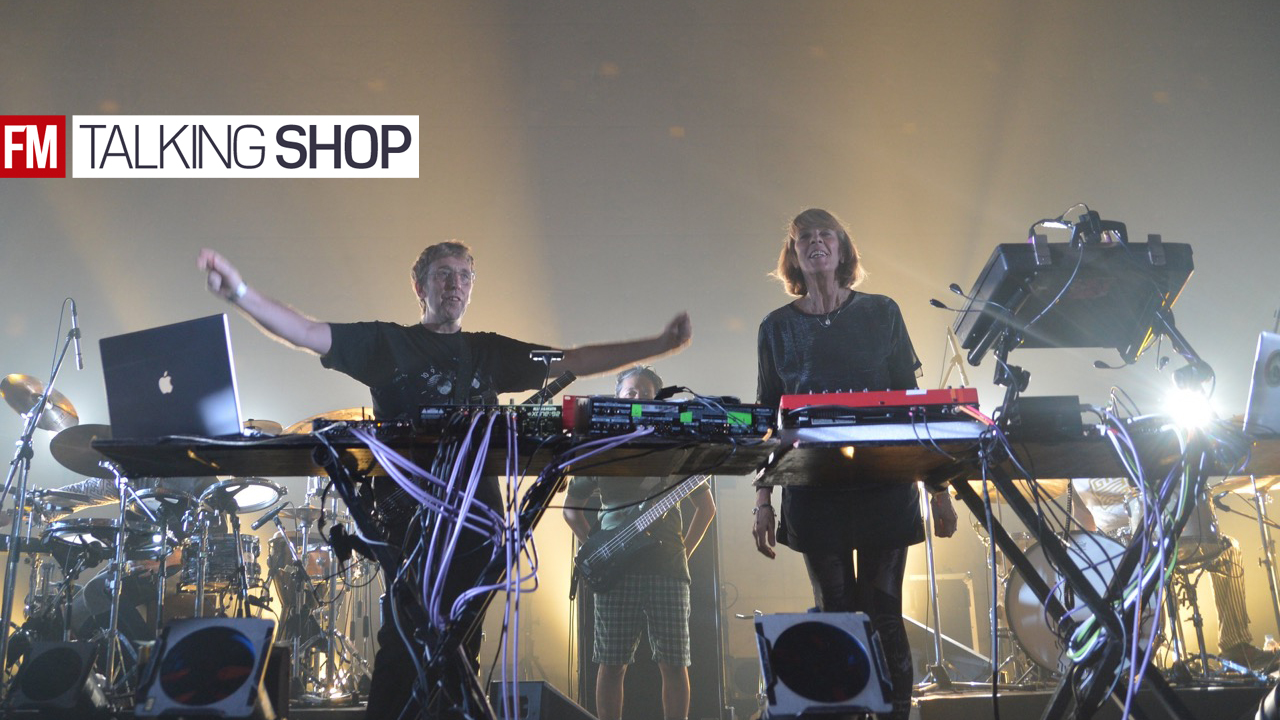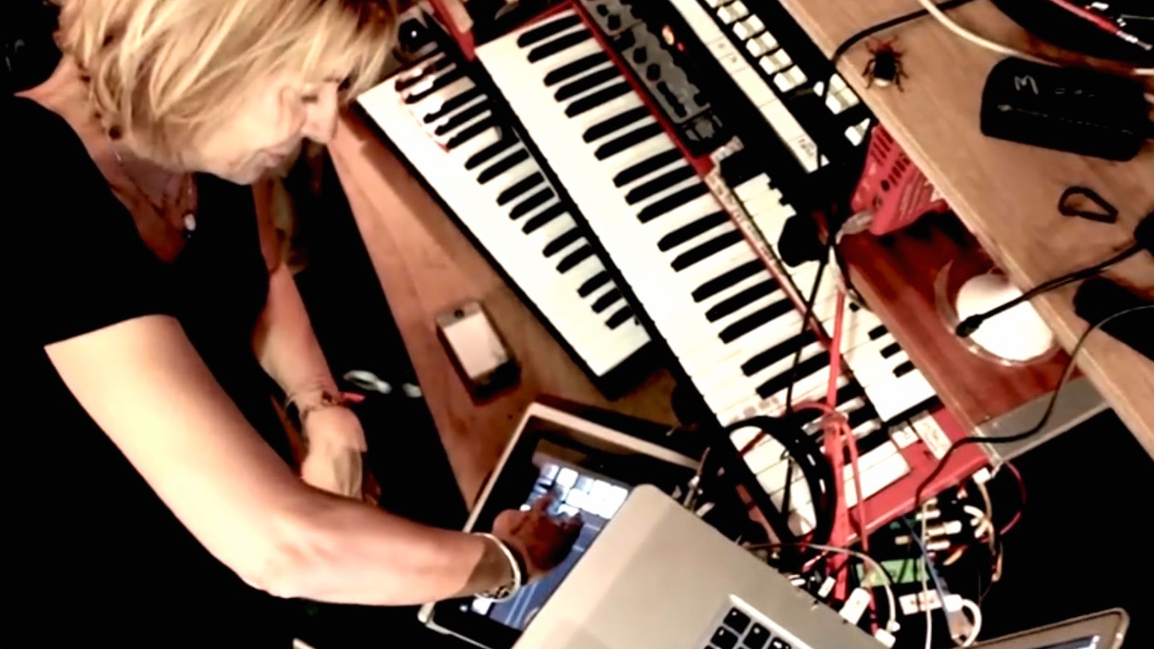Talking Shop: System 7
We talk gear with the UK ambient stalwarts

Almost 25 years on from the release of their debut LP, Steve Hillage and Miquette Giraudy, the duo at the heart of London-based ambient outfit System 7, are still exploring the limits of recording technology in order create their unique textural brand of guitar and synth-led electronic music.
With a pair of new albums out this month - a System 7 LP and an ambient leaning effort as Mirror System - we caught up with Hillage to chat about how the group's studio and approach to production has changed over the years.
When did you start making music, and how did you first get started?
"I started learning piano at the age of four, but switched to guitar at the age of nine. Got my first electric guitar at the age of 13 and after a couple of years my playing was pretty good. I recorded my first studio album (called Arzachel) at the age of 17, while still at school.
"I decided to leave Kent University and to do music as a full time career at the age of 20 and got my first record deal soon after, largely through my contacts with fellow Canterbury musicians, signing a management deal with Caravan's management. But as well as playing guitar I always wanted to be a record producer. For me the two things have gone hand in hand."
Tell us about your studio
"For the last 18 years our studio has been in a rented business unit in North Notting Hill, near Ladbroke Grove. There are quite a lot of other studios in our building, and at night the place is often buzzing, which I like. Our studio is computer based, and for the last 12 years I have been mixing "in the box". I have a nice little recording room next to the control room for vocals or other live instruments. A few years ago I downsized the mixer to a 16-channel Mackie Onyx 1640i, which I find excellent. I control the monitoring through the (unfortunately named) Mackie Big Knob.
Want all the hottest music and gear news, reviews, deals, features and more, direct to your inbox? Sign up here.
"When we moved into this unit in 1997 we spent quite a lot of money to get it acoustically designed and treated, using the company Recording Architecture. They did a great job. It's not a perfect acoustic space but over the last 18 years I've got to know it really well. I still use the same speakers and amp (KRK 900-B speakers C-Audio Amp) in the main room, and, with the acoustic design, it's really served me well over the years as a reliable mixing environment."

What DAW (or DAWs) do you use, and why did you choose it?
"I got my first Apple II computer in 1979 and have since then been strongly interested in computer based music production. My first computer midi sequencer was UMI on the BBC computer, then Steinberg Pro 24 on the Atari, and then moving to C-Lab Notator also on the Atari. The first System 7 and Orb tracks were made with Notator as the main sequencer, but still using 24 track tape as the recording medium (synced using Unitor).
"On those early tracks in 1990 we did quite a few alternative mixes and improvised arrangements and there was a major need for editing. We recorded our mixes to DAT, and transferring the DAT to ½-inch tape for editing was a slow and costly procedure. A friend told me about Soundtools on a Mac, that could be rented from Dreamhire (now FX Rentals) and this was our solution! I loved Soundtools and did a lot of really creative editing with it. The 39min 57sec version of Blue Room by The Orb would have been impossible without Soundtools!
"As I was now both a C-Lab and a Digidesign user, the next obvious step was to move to Logic on Mac, quite soon after it first came out. Logic, as is well known, was originally made by the C-Lab engineers, before being bought up by Apple. A year before we set up our studio I bought a large top of the range Power Mac and Logic TDMsystem, which I used for about 5 years, also learning to use Pro Tools. When it came time to upgrade I was, by now, in love with Pro Tools as the ultimate mixing and editing system, and so I switched to total Pro Tools HD operation with my new system, which I have since upgraded twice. Working fully in the digital audio domain, with all the editing possibilities of Pro Tools, is pretty much perfect for me.
"My partner Miquette uses Logic and also her iPad to create her parts, and I also create some things on Ableton or on standalone Native Instruments modules. But it all ends up on audio tracks in Protools and that is where the heavy mixing takes place."
What one piece of gear in your studio could you not do without, and why?
"I'm very much in favour of the concept that it's better to have fewer devices that you know very well rather than a lot of devices that you know less well. So from this point of view, most of the items in our studio we couldn't really do without! But if I was forced to prioritise I would of course say my Power Mac Protools Rig, my Steinberger guitar, and my Line 6 Pod XT Pro rack unit.
"The guitar and the Pro Tools are obvious choices that hardly need further explanation. The Line 6 is one of several amp simulating guitar processors that I use, but it's the one I use by far the most and I have a large store of guitar patches I have made for it. Also I use the AES/EBU digital output on the Line 6 for recording directly into Pro Tools. And for guitar recording I don't use the delay effects on the Line 6, but instead use Pro Tools plugins like Soundtoys Echo Boy (a really great plugin). This makes it much easier to tighten up the timing of my guitar parts as the audio is recorded dry of delay."
What's the latest addition to your studio?
"The Signal plugin by Output is the last item I acquired and it's been used to good effect on the new Mirror System and System 7 albums. Signal is a set of instruments designed to work with Native Instruments Kontakt 5. This and its predecessor Rev are the only new items I've got in the last 2 years. One thing that interests me is the new Moog Mother 32 module - that looks like fun! And I am also interested in updating my guitar processor to either the newer Line 6 Pod XT pro HD rack or the even newer Line 6 Helix Rack."
What dream bit of gear would you love to have in you studio?
"This is not really a dream, more a nightmare! My current Power Mac and Pro Tools needs upgrading, but since I'm now several versions behind I need to upgrade the whole shebang, including all the plugins. The main problem is that the old-style Power Macs, which allow you to install the Pro Tools circuit cards internally, are no more. They are now replaced by these smaller, and admittedly more cute, round black things for which the Pro Tools hardware has to be placed in an external chassis. I'm going to have grab the bull by the horns soon and sort out this upgrade - but at the moment I find it somewhat scary."
When approaching a new track or project, where do you start?
"We start tracks in a whole variety of ways: a certain sound that inspires something, a sample, a groove, a guitar riff, a Miquette synth idea. And yes we also like just jamming and recording stuff at random - this can be an excellent starting point if, on listening back to the jam, we identify a great little bit and are able to reproduce it (the reproducing is not always easy!)
"Also I have a faculty of being able to imagine in my mind snatches of complete arrangements, that often arrive my head completely by hazard or even in a dream. I often record little sung parts into my iPhone iRig recorder, to help me remember imagined ideas. Then the challenge is again to try to reproduce a little bit of what I heard in my head and then subsequently turn it into a proper track."
What are you currently working on?
"The big project for us this year is the simultaneous release of our new full power System 7 album titled X-Port and the more chilled Mirror System album titled N-Port. We've been working on these two albums for the best part of the last year. This somewhat ambitious dual release plan celebrates the 21 year anniversary of our System 7 Fire and Water dual albums, which also presented both our dancefloor and our ambient side.
"N-Port (Mirror System) and X-Port (System 7) were released on October 16th. It's a major release and presents the full range of our work in the electronic field. We're also playing a bunch of promotional shows for this, starting with the Jazz Café in London on Wed Oct 28th."
System 7's three essential music making tips
Timing is ultra-important
"Getting the various tracks in a mix to sit right timing-wise is the key to a good mix. When parts are grooving properly it removes some of the need for EQ. This doesn't just apply to drum and rhythmic parts, but also to vocals and lead instruments. When phrases are in the pocket the brain hears them more comfortably, so there is also a bit less need for excessive volume rides. With Pro Tools, I often use the nudge keys ("+" or "-") set at 10 sample steps on separated regions, while cycling around specific sections, moving bits around until it sits nicely."
The 300hz thing
"A classic cause of muddiness in mixes is a build-up of the low mid frequencies that are generally the fundamental harmonics of the instruments. This can be cured by selective EQ dipping in the 300hz area of various instruments and vocals too. You need to fish around for the best frequency and Q to use on the instruments you want to apply this dipping too - and you certainly don't need to do this to every track. You just need to decide which tracks need to retain their low mid fatness and which tracks to apply the low mid EQ dip to. For me it's a pretty intuitive process."
Less is more
"Often the most powerful and moving arrangements are with relatively few components. Yes, I know it's not always the case, and that sometimes layering a lot of different components is what a particular piece is all about. But even if you are doing a complex layering mix job, if you keep in the back of your mind the concept of "less is more" it will help you achieve a good result. Sometimes losing a couple of parts, even if you thought they were vital when you were recording them, gives you a more powerful end result. Sometimes you need a certain ruthlessness."


Future Music is the number one magazine for today's producers. Packed with technique and technology we'll help you make great new music. All-access artist interviews, in-depth gear reviews, essential production tutorials and much more. Every marvellous monthly edition features reliable reviews of the latest and greatest hardware and software technology and techniques, unparalleled advice, in-depth interviews, sensational free samples and so much more to improve the experience and outcome of your music-making.
